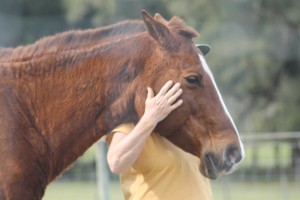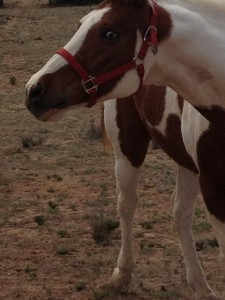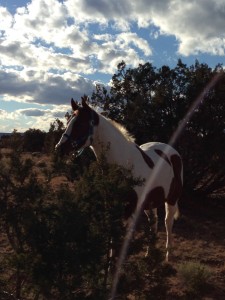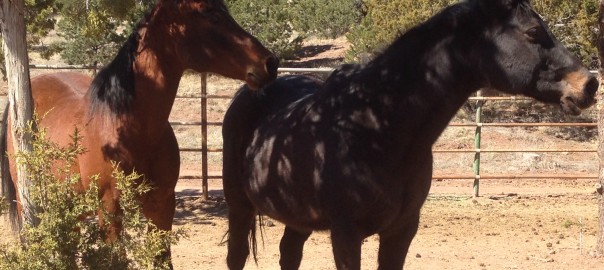One reason I like to teach Liberty Foundations is because it offers a true reading of the horse, but it also gives a true reading of the person working with the horse.
When people work with the horses that come to the clinics, they are often working with horses who don’t know the Liberty Foundations at all, and start from scratch. We begin with some dimensional exercises, to be sure we are not carrying unwanted baggage into the workspace with the horse, that may influence how she is responding. This also shows what we need to do to adjust our energy.
Once we are with the horse, we can see what further adjustments need to be made with energy.
I start the horse, then the owner or attendee will work with the horse, and start building the foundations, and in turn, the relationship. What is beautiful is that we work toward the horse being able to transfer her knowledge of one relationship to the next student, and refine that knowledge and connection with each student.
Often people work with horses who are not their own, and this is sometimes freeing in terms of not dealing with an ongoing relationship. It allows students to also experience a number of different horse personalities and energies.

If the person has brought their own horse, sometimes the person’s relationship with their own horse is one where the horse takes advantage of some aspect of the person. Or the person is so accustomed to their own horse, that they don’t correct their horse with any show of leadership. Or their energy is too strong for that particular horse.
There is what I call a “tipping point,” where the owner or handler can become uncentered in trying to get their horse to do something. Once they are uncentered, their influence over the horse diminishes. I have had this happen to me, and it’s important to recognize it as it comes out of our desire to effect a change. It also comes out of our desire to have the horse love us and want what we want.
Consider asking these questions:
1. Does your horse step into your space when you are working with her?
2. Does your horse ignore you a large amount of the time?
3. Is your horse agreeable but seems to have no real life in her for the work you’re doing together, or tries to hurry through it?
4. Do you feel yourself tumbling toward your horse, in your eagerness to have her like you and do things with you?
 One of the important things about Liberty Foundations is there is essentially no agenda. The steps are sitting with the horse, greeting the horse, moving with the horse, in ways that are common and familiar to the horse. If the horse chooses not to engage, it’s not a big deal.
One of the important things about Liberty Foundations is there is essentially no agenda. The steps are sitting with the horse, greeting the horse, moving with the horse, in ways that are common and familiar to the horse. If the horse chooses not to engage, it’s not a big deal.
If the horse continually chooses not to engage, then we aren’t being engaging enough! We can read the intention of the horse and read our own intentions. What do we want? What do we want the horse to do? He refuses to connect!
We are looking for willing participation. In other forms of horsemanship, people can have great results with a lot of horses, but the horses are not always willing participants.
The way we work in Liberty Foundations is in a larger space, a small arena, with corners or even a paddock, where the horse has the freedom to leave any time he or she wants.
Through our sitting with and greeting the horse, the horse learns to accept our presence in the herd. Through our walking behind her, she learns that we can have the same influence as other horses, and can come into rhythm with her. Changing that up to walk beside her, and we are companions, taking a stroll together, looking at the horizon, grazing, spending time like a horse. Moving the horse away and inviting her back, she learns that the relationship has a flow, that some space is necessary in the relationship, but that we will come back to each other with a stronger bond.

Out of this quiet, focused effort, our horses will want to engage. Their interest in activities we introduce will increase. We’ll learn what their preferences are and be able to make modifications and bring joy. Other training methods will grow organically from these Liberty Foundations as we continue to move along the pathway to introducing what we need in our training programs.
I have included some videos of the work, with myself and students, with horses who are both ridable and not, with horses who have had a lot of Liberty Foundations and those who have had none.
We are seeking a change, a shift in relationship, by allowing it to emerge. We want eyes, ears, gestures, to all point to a soft, willing horse, not one who is just going through the motions.
To get this, we need to be specific in our directions, and not be tipped over into wanting certain responses, seeking love or understanding, seeking a bond that will come if the person just stays centered, breathing, in the moment.
It’s important for the person to increase the amount of time they can stay in the moment, which will naturally increase as they practice this work. The horse always lives in the moment, so she can guide us on this journey.
If you’ve answered “yes,” to any of the questions posed above, see if you can change that around as you work with Liberty Foundations.
Videos:
The Shaping of a Liberty Horse
Prairie Flower with Jazzmine and Lorrin
Transitioning to Riding from Liberty Foundations Groundwork, September 2013 Clinic
(c) Susan Smith, Horses at Liberty Foundation Training, Equine Body Balance (TM)
Please see my
Events for information on upcoming clinics and workshops.


















